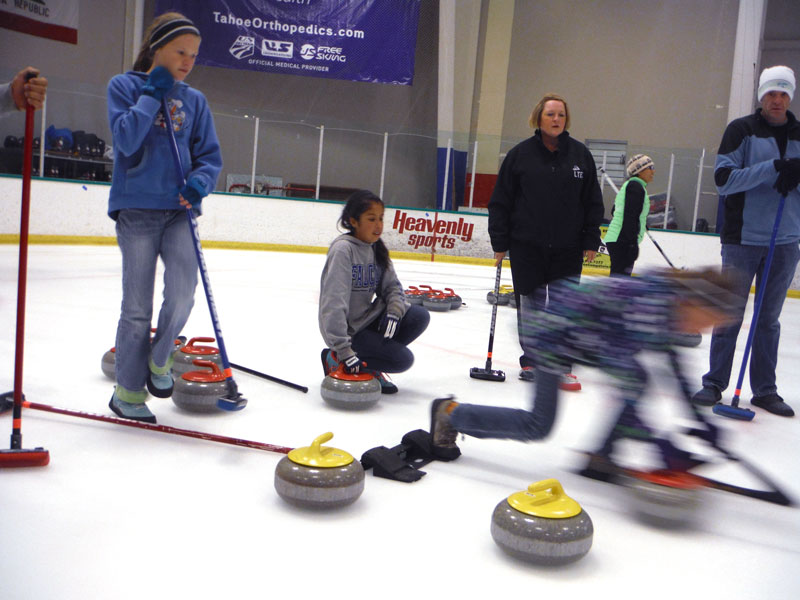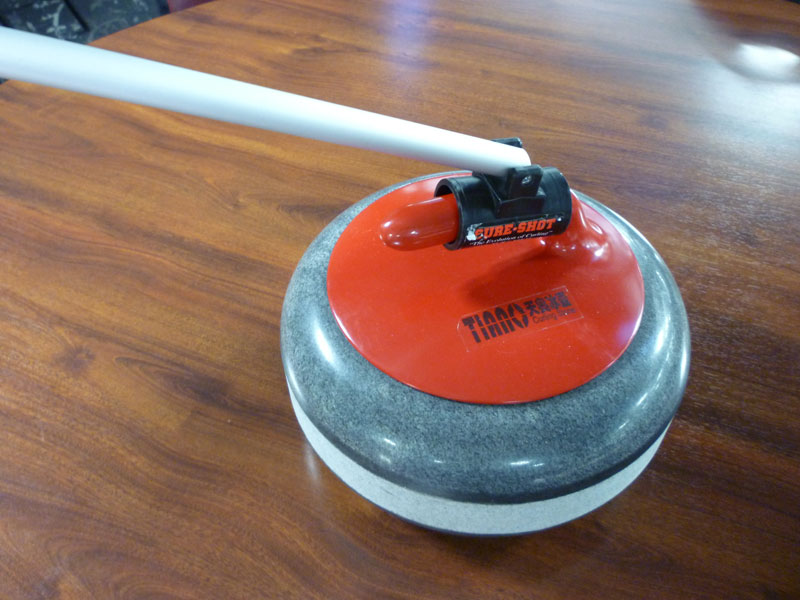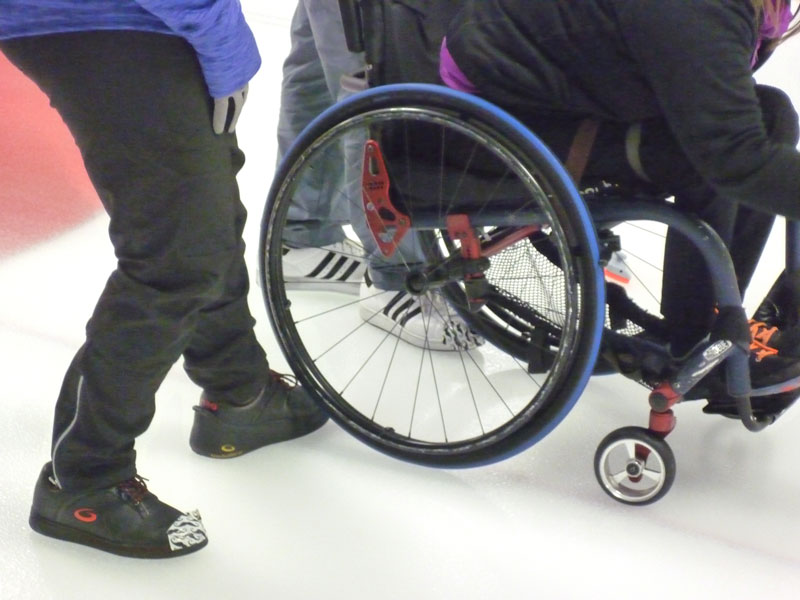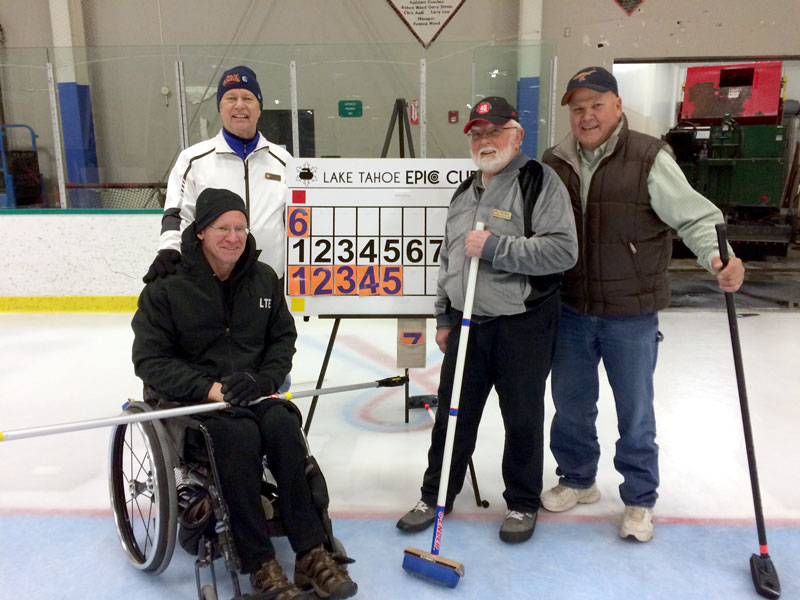Enthusiastic shouts of encouragement and direction from team members along with the low grumble of a flat-bottomed round stone trundling its way down the ice sheet toward the target zone fill the high ceiling building. Rapid "zip, zip, zip, zip, zip" sounds rise from the small bristle-less push brooms being scrubbed against the ice to help sweep an advantageous path for the polished stone on its way to strategic placement in a horizontal target called the "house."
Players, some with stopwatches in hand, monitor the travel speed of the stone and call out timing information to the teammate delivering the 38 to 44-pound stone. The placement of stones, angles of delivery, and strategies are all pondered aloud publicly in practice and competition. Each team hearing the other's strategy and viewing the full playing area and location of stones.
What kind of competition is this where the game plan is openly discussed for both sides to hear? Shouldn't scoring plans and defensive moves be whispered behind a clipboard like in so many other sports? How is it that players in wheelchairs and those without disabilities compete on the same team? Is this an alternate universe? No, this is the sport of curling, and it is rapidly gaining popularity as competitive and recreational leagues flourish across the country and around the world.

Curling is a team sport with four members and categories for men, women, and mixed teams. The specially prepared 150' by 16'5" ice sheet has several sets of marking lines pertinent to play, plus circular scoring targets of four concentric rings called the "house" at each end of the ice. Play occurs with team members at both ends of the ice and and stone delivery alternates between teams one at a time until eight stones by each team have been delivered toward the house at the far end of the sheet. The basic premise of curling is to score points for your team by sending a perfectly paced and directed curling stone down the ice to either land in a scoring zone, knock an opponent's stone out of a scoring zone, or block an opponent from reaching a scoring zone. Specific rules govern the release of the stone and sweeping tactics, which are used to control the direction of a team member's stone or an opponent's stone. Curling teams often play on typical ice rinks rather than special ice sheets. It is a game of focus and strategy, with similarities to billiards, shuffleboard, chess, and boccia.
Recently, Olympic curling has been broadcast on television from the Games in PyeongChang and curling will be featured at the Paralympic Games in South Korea as well. To be clear, Paralympic curling, added to the games in 2006, includes only players who use wheelchairs and the stones are delivered using a delivery stick rather than physically grasping the handle affixed to the top of the stone. The single rule modification to the game regards sweeping - none is allowed. Paralympic curlers must rely on precise speed and direction during delivery of the stone to gain accurate placement of the rock in the house or to block pathways of the opponent's stones or bump them out of play. Recreational curling with inclusive teams does include sweeping, which is done by the standing players.
Peter Axleson and Pam Wilson are recreational curlers, and although they live several states apart, they meet occasionally at Wheelchair Curling Bonspiels or curling competitions. Each was looking for a new lifetime sport to enjoy and had a mild interest in experiencing curling after watching it on television. Both participated in a "Learn to Curl" event and found, surprisingly, that the sport was fun, and one could easily pick up reasonable skill and the basic rules in a couple hours. Modifications include the above-mentioned use of a delivery stick rather than using the handle of the stone and asking someone to steady his or her wheelchair during the delivery of the stone. In the true spirit of curling, the personal who stabilized the wheelchair of a player may be a competitor or teammate, whomever is nearby. The sport is all about fair play and encouraging every player to exhibit the highest skill possible.

Peter is an engineer and says he likes the sport because it feeds his analytical brain with angles, speeds, and understanding the stone's co-efficient of friction. He also says it is a sport he can continue when he is no longer able to participate in more physical activities like alpine mono-skiing. Peter plays with Lake Tahoe Epic Curling. Pam says she enjoys the challenge of expanding her stone delivery skill, refining strategies to play the game in different ways, the low impact on her body, and not having to haul a bunch of athletic gear with her to play. Pam's delivery stick is made of carbon fiber and breaks down into three small sections. Delivery sticks can be as simple as a plastic "head" screwed onto a paint roller extension stick. Stand curlers who cannot bend to the ice to grasp the handle of a stone also use delivery sticks, so these devices are routinely found at curling centers and ice rinks where curling leagues compete. Pam and Peter play in leagues with stand curlers without disabilities. All agree that the playing field is level between standing and sitting team members. Pam plays with the Denver Curling Club and is also on the National Wheelchair Curling Team but will not be participating in the PyeongChang Games.

Ask any curler what continues to keep them close to the game and players may cite the technical aspects of the game or the competition itself, but all will tell you about the culture of community that runs deep in curling. The importance of connection in the sport leads curlers to describe the camaraderie, ability to participate individually or as a family, fun, fellowship off the ice, opportunities to learn from each other, encouragement from your opponents, trust in each other to call your own rule violations, and the fact that experienced curlers take the time to bring along the next generation of players whether they stand or roll on the ice.
Learn More About Curling
Watch this quick game tutorial to learn about the concept of curling.
For more information about curling technique and rules, check out this video.
Get Started Curling
Find friendly curling clubs in the United States by visiting the Team USA website or check out this list of curling clubs elsewhere in the world. Ask about Learn to Curl events. Be sure to ask if the ice rink is accessible.
High Level Curling Competition Information and Opportunities
Click here for info on Paralympic curling.
Visit WorldCurling.org for information on curling at the PyeongChang Paralympic Games March 10-17, 2018.
Chat with a Wheelchair Curler
Contact Pam Wilson at Pamelae.Wilson@icloud.com if you would like to communicate directly with a curler who uses a wheelchair.

About the Author
Beth Fox is a longtime leader in the field of adapted sports, recreation, and education. She is known nationally and internationally as a creator, author, presenter, and implementer of programs with processes that support high quality, innovative programming to improve the lives of people with physical, cognitive, and social/emotional disabilities. With more than 30 years of experience in nonprofit organizations, public education, recreation districts, and professional associations, Beth brings an unparalleled level of technical expertise and creativity to adapted physical education, sports, and recreation. Beth has a unique ability to make a human connection with individuals and large groups, respecting differences and needs that are often not addressed in typical educational settings. This connection empowers people to achieve their personal goals.
Most of the stories here on LiveQuickie.com were submitted by readers. Do you have a story to tell? We'd love to hear it. Submit your story here.